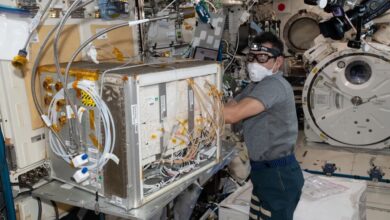NASA
Sinister Solar System

Our universe is full of mysterious sights and sounds. Explore some of our most frightful finds from past Halloweens.
Sinister Solar System Features
 These eye-catching posters depict some of the universe’s most mysterious astronomical phenomena with artistic flair.01NASA Posters Feature Cosmic Frights for HalloweenExplore NASA’s Galaxy of Horrors posters. Presented in the style of vintage horror movie advertisements, the new posters feature a “dead” galaxy, an explosive gamma ray burst caused by colliding stellar corpses, and ever-elusive dark matter.See the Posters
These eye-catching posters depict some of the universe’s most mysterious astronomical phenomena with artistic flair.01NASA Posters Feature Cosmic Frights for HalloweenExplore NASA’s Galaxy of Horrors posters. Presented in the style of vintage horror movie advertisements, the new posters feature a “dead” galaxy, an explosive gamma ray burst caused by colliding stellar corpses, and ever-elusive dark matter.See the Posters The red giant star CW Leonis resembles orange-red cobwebs.02Hubble Celebrates Halloween With a Glowering, Dying StarA hypnotizing vortex? A peek into a witch’s cauldron? A giant space-spider web? Nope, it’s a Hubble image of the red giant star CW Leonis. The image comes just in time for celebrating Halloween with creepy celestial sights.Explore CW Leonis
The red giant star CW Leonis resembles orange-red cobwebs.02Hubble Celebrates Halloween With a Glowering, Dying StarA hypnotizing vortex? A peek into a witch’s cauldron? A giant space-spider web? Nope, it’s a Hubble image of the red giant star CW Leonis. The image comes just in time for celebrating Halloween with creepy celestial sights.Explore CW Leonis A line drawing highlights parts of this nebula that resemble the movie monster Godzilla.03A ‘Monster’ Star-Forming Region Spied by NASA’s SpitzerDo you see a monster in this picture? Do the bright spots near the top of the image look like the piercing eyes and elongated snout of Godzilla?More About the ‘Monster’
A line drawing highlights parts of this nebula that resemble the movie monster Godzilla.03A ‘Monster’ Star-Forming Region Spied by NASA’s SpitzerDo you see a monster in this picture? Do the bright spots near the top of the image look like the piercing eyes and elongated snout of Godzilla?More About the ‘Monster’ This animation was created using radar data collected by the National Science Foundation’s 1,000-foot (305-meter) Arecibo Observatory in Puerto Rico.04That Halloween When a Dead Comet Flew by EarthA large space rock zipped past Earth on Halloween in 2015. It most likely was a dead comet and, fittingly, it had an eerie resemblance to a skull.Explore
This animation was created using radar data collected by the National Science Foundation’s 1,000-foot (305-meter) Arecibo Observatory in Puerto Rico.04That Halloween When a Dead Comet Flew by EarthA large space rock zipped past Earth on Halloween in 2015. It most likely was a dead comet and, fittingly, it had an eerie resemblance to a skull.Explore This image of Venus was taken by NASA’s Magellan spacecraft.05Hellish ‘Evil Twin’ Venus Broils and Crushes SpacecraftIt’s a cloud-swaddled planet named for a love goddess, and often called Earth’s twin. But pull up a bit closer, and Venus turns hellish.More About Venus
This image of Venus was taken by NASA’s Magellan spacecraft.05Hellish ‘Evil Twin’ Venus Broils and Crushes SpacecraftIt’s a cloud-swaddled planet named for a love goddess, and often called Earth’s twin. But pull up a bit closer, and Venus turns hellish.More About Venus The Lucy fossil photographed in 2009.06Lucy Spacecraft is Named for a SkeletonAround Halloween 2021, NASA launched the Lucy mission on a journey to a part of our solar system that has swarms of mysterious Trojan asteroids. And the spacecraft is actually named for a skeleton! Lucy is named for a fossilized skeleton of a human ancestor, which was named for the Beatles song “Lucy in the Sky with Diamonds.”Learn About Lucy’s Name
The Lucy fossil photographed in 2009.06Lucy Spacecraft is Named for a SkeletonAround Halloween 2021, NASA launched the Lucy mission on a journey to a part of our solar system that has swarms of mysterious Trojan asteroids. And the spacecraft is actually named for a skeleton! Lucy is named for a fossilized skeleton of a human ancestor, which was named for the Beatles song “Lucy in the Sky with Diamonds.”Learn About Lucy’s Name Pulsar wind nebulas like MSH 15-52 are clouds of energetic particles, producing X-rays, that are driven away from dead collapsed stars. X-rays from Chandra (gold and blue); infrared from the Dark Energy Camera KPNO Blanco 4.0m (red and blue)07NASA X-ray Telescopes Reveal the “Bones” of a Ghostly Cosmic HandIn 1895, Wilhelm Röntgen discovered X-rays and used them to image the bones in his wife’s hand, kicking off a revolutionary diagnostic tool for medicine. Now two of NASA’s X-ray space telescopes have combined their imaging powers to unveil the magnetic field “bones” of a remarkable hand-shaped structure in space. Together, these telescopes reveal the behavior of a dead collapsed star that lives on through plumes of particles of energized matter and antimatter.Learn More
Pulsar wind nebulas like MSH 15-52 are clouds of energetic particles, producing X-rays, that are driven away from dead collapsed stars. X-rays from Chandra (gold and blue); infrared from the Dark Energy Camera KPNO Blanco 4.0m (red and blue)07NASA X-ray Telescopes Reveal the “Bones” of a Ghostly Cosmic HandIn 1895, Wilhelm Röntgen discovered X-rays and used them to image the bones in his wife’s hand, kicking off a revolutionary diagnostic tool for medicine. Now two of NASA’s X-ray space telescopes have combined their imaging powers to unveil the magnetic field “bones” of a remarkable hand-shaped structure in space. Together, these telescopes reveal the behavior of a dead collapsed star that lives on through plumes of particles of energized matter and antimatter.Learn More Scientists think `Oumuamua must be very elongated because of its dramatic variations in brightness as it tumbled through space.08Mystery Visitor to Our Solar System is a Strange, Tumbling ObjectIn November 2017, scientists pointed NASA’s Spitzer Space Telescope toward the object known as ‘Oumuamua – the first known interstellar object to visit our solar system. The infrared Spitzer was one of many telescopes to study ‘Oumuamua in the weeks after its discovery that October.Explore ‘Oumuamua
Scientists think `Oumuamua must be very elongated because of its dramatic variations in brightness as it tumbled through space.08Mystery Visitor to Our Solar System is a Strange, Tumbling ObjectIn November 2017, scientists pointed NASA’s Spitzer Space Telescope toward the object known as ‘Oumuamua – the first known interstellar object to visit our solar system. The infrared Spitzer was one of many telescopes to study ‘Oumuamua in the weeks after its discovery that October.Explore ‘Oumuamua NASA’s Viking 1 Orbiter spacecraft photographed this “face” on Mars on July 25, 1976, while searching for a landing site for the Viking 2 Lander.09Strange, Alien Face on MarsNASA’s Viking 1 Orbiter spacecraft photographed this region of Mars on July 25, 1976, while searching for a landing site for the Viking 2 Lander. Due to processing errors, the photo became famous because it resembles a human (or maybe alien?) face.Learn More About the ‘Face’
NASA’s Viking 1 Orbiter spacecraft photographed this “face” on Mars on July 25, 1976, while searching for a landing site for the Viking 2 Lander.09Strange, Alien Face on MarsNASA’s Viking 1 Orbiter spacecraft photographed this region of Mars on July 25, 1976, while searching for a landing site for the Viking 2 Lander. Due to processing errors, the photo became famous because it resembles a human (or maybe alien?) face.Learn More About the ‘Face’ An image of the planet Uranus taken by the spacecraft Voyager 2 in 1986.010’Sideways’ Planet Uranus Likely Got WhackedUranus is the only planet whose equator is nearly at a right angle to its orbit, with a tilt of 97.77 degrees – possibly the result of a collision with an Earth-sized object long ago.Explore the ‘Sideways’ Planet
An image of the planet Uranus taken by the spacecraft Voyager 2 in 1986.010’Sideways’ Planet Uranus Likely Got WhackedUranus is the only planet whose equator is nearly at a right angle to its orbit, with a tilt of 97.77 degrees – possibly the result of a collision with an Earth-sized object long ago.Explore the ‘Sideways’ Planet
Sinister Sounds of the Solar System
Have you heard the scary noises from across our universe before? Using data from our spacecraft, scientists gathered sinister sounds from the depths of space. Listen to our playlist filled with new “moans” and “whistles” that would scare the most ghoulish of creatures.
Halloween Activities and Downloads
- 01Decorate Your Walls With the ‘Horrors’ of Our GalaxyLearn more about zombie worlds, rains of terror, and flares of furry when you decorate your walls with the Galaxy of Horrors posters. Get in the sinister spirit and download the posters here.Download
- 02Enjoy Planet CandiesA whimsical collection of cosmic candies. Ready to download and share. Enjoy.Download Candy Planets
- 03Carve a Pumpkin Like a NASA EngineerOur engineers are famous for designing spacecraft and telescopes, but did you know they were out-of-this-world pumpkin carvers? View their handiwork.See the Pumpkins
- 04Dress Up as Your Favorite PlanetLooking for easy costume ideas this year? Become one of your favorite planets! Download these printable face cut-outs.Download
- 05Use Candy to Describe Rocks like a ScientistPick your favorite Halloween candy bar and learn how to study rocks like NASA scientists do!Explore
- 06Travel to the Universe of MonstersIn dark corners of the galaxy are worlds fit for creatures of the night. Explore the homes of Frankenstein’s monster, Dracula’s lair, the place where zombies roam, and more.Start Your Journey





